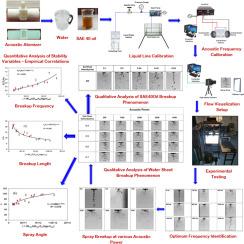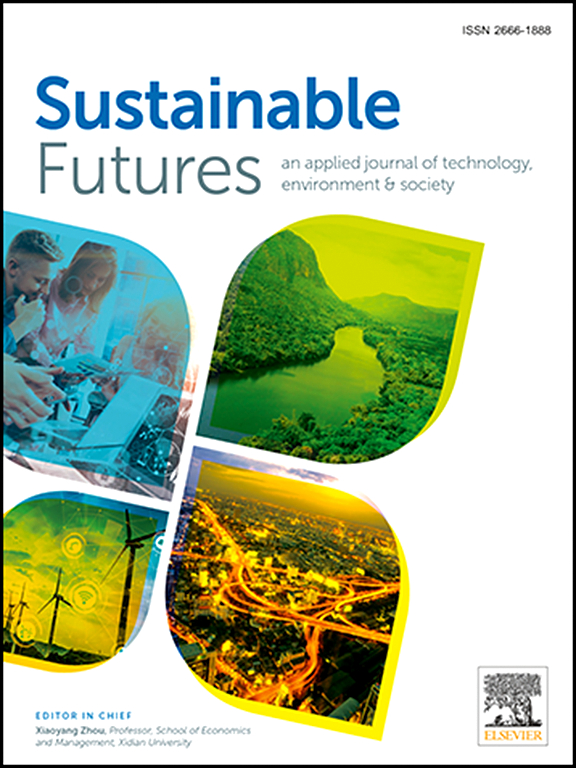Development of empirical correlations for sustainable breakup characterization of water and high-viscous oil sheets under acoustic perturbations using high-speed imaging
IF 4.9
2区 社会学
Q2 ENVIRONMENTAL SCIENCES
引用次数: 0
Abstract
Efficient techniques for breaking liquid columns into smaller droplets are highly valued in atomization and spray dynamics research. The investigation focussed on the development of a miniature acoustic atomizer to disrupt high-viscosity liquid sheets using precisely tuned acoustic frequencies. The key innovation of this study is the design and fabrication of a compact liquid sheet acoustic atomizer that efficiently utilizes acoustic energy to produce high-quality sprays. This study employs minimal power for liquid disintegration compared to the high-power demands of other air-assisted systems, aiming to promote sustainable growth. Dynamic acoustic calibration was employed to determine the dominant frequency, likely establishing a standing wave within the atomizer cavity. At resonance, this standing wave effectively transfers acoustic energy to the liquid sheet, significantly enhancing its fragmentation. The breakup dynamics of water and SAE 40 oil were captured using high-speed imaging coupled with backlit flow visualization techniques.
Morphological characteristics of the breakup process were qualitatively analyzed using ImageJ, an open-source image processing tool. Subsequently, quantitative analysis has been carried out to the formulate breakup stability empirical results. The minimum breakup length of 7.6 mm and maximum spray angle of 115° and maximum breakup frequency of 1960 Hz was noticed for water sheet breakup. Better correlations have been established for breakup length, spray angle, breakup frequency, interfacial wavelength and critical wave number as a function of newly proposed acoustic number. This provides valuable insights into the role of acoustic energy in the high viscous liquid breakup. The study underscores significant advancements in optimizing acoustic atomization with broad industrial implications. Further studies may focus on refining compression driver designs and noise filtration techniques to achieve enhanced control and efficiency, expanding the applicability of acoustic atomizers.

利用高速成像技术开发水和高粘性油层在声波扰动下的可持续破裂特征的经验相关性
在雾化和喷雾动力学研究中,将液体柱分解成小液滴的有效技术受到高度重视。研究的重点是开发一种微型声学雾化器,利用精确调谐的声学频率来破坏高粘度的液体片。本研究的关键创新是设计和制造一种紧凑的液体片声雾化器,有效地利用声能产生高质量的喷雾。与其他空气辅助系统的高功率需求相比,本研究采用最小功率进行液体分解,旨在促进可持续增长。采用动态声学校准来确定主导频率,可能在雾化器腔内建立驻波。在共振时,驻波有效地将声波能量传递给液片,显著增强了其破碎性。利用高速成像和背光流可视化技术捕捉了水和sae40油的分解动力学。利用开源图像处理工具ImageJ对破碎过程的形态学特征进行定性分析。随后,对配方破碎稳定性的实证结果进行了定量分析。水板破碎的最小破裂长度为7.6 mm,最大喷射角为115°,最大破裂频率为1960 Hz。实验结果表明,破裂长度、喷射角、破裂频率、界面波长和临界波数与新提出的声数有较好的相关性。这为声波能量在高粘性液体破裂中的作用提供了有价值的见解。该研究强调了优化声雾化方面的重大进展,具有广泛的工业意义。进一步的研究可以集中在改进压缩驱动器的设计和噪声过滤技术,以提高控制和效率,扩大声学雾化器的适用性。
本文章由计算机程序翻译,如有差异,请以英文原文为准。
求助全文
约1分钟内获得全文
求助全文
来源期刊

Sustainable Futures
Social Sciences-Sociology and Political Science
CiteScore
9.30
自引率
1.80%
发文量
34
审稿时长
71 days
期刊介绍:
Sustainable Futures: is a journal focused on the intersection of sustainability, environment and technology from various disciplines in social sciences, and their larger implications for corporation, government, education institutions, regions and society both at present and in the future. It provides an advanced platform for studies related to sustainability and sustainable development in society, economics, environment, and culture. The scope of the journal is broad and encourages interdisciplinary research, as well as welcoming theoretical and practical research from all methodological approaches.
 求助内容:
求助内容: 应助结果提醒方式:
应助结果提醒方式:


